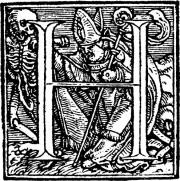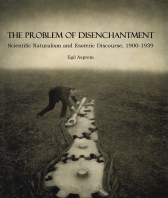I was recently reminded of an article I was commissioned to write a long time ago. The topic is Goetia and modern western ritual magic. With the deadline approaching it is time to start brainstorming a bit. So be patient: rambling speech ahead!
The chapter gives me an opportunity to look at something that is typically of interest to social theorists and anthropologists: the way people draw distinctions. Lately I have been most interested in distinctions when it comes to attempts at demarcating science and non-science, with all of its philosophical, political, ideological, social, and even ethical ramifications. But the distinctions being made within cultural systems are equally fascinating. When it comes to magic in a western context, demarcations have commonly been of a moral and theological nature. Is there a lawful magic, or is it all wrong?
“Goetia” is one of several words from ancient Greek which came to signify magic, sorcery, or witchcraft. In antiquity it was for a while the preferred term in Attic Greek, while the Romans adopted another Greek word, mageia (probably of Persian origin), which eventually gave us “magic” and associated words in modern European languages.
By the Renaissance the word goetia started to be used as a part of classifications of different types of magic. In his survey and criticism of all known arts and sciences, De incertitudine et vanitate scientiarum (1531; shortened title; “On the uncertainty and vanity of the sciences”), Heinrich Cornelius Agrippa distinguished between natural magic, mathematical magic, enchanting magic, juggling or legerdemain (closer to what most people today associate with the term “magic”), and ceremonial magic. Furthermore, he subdivided ceremonial magic into the two types of Goetia and Theurgia.
The distinction was a theological one. Theurgic magic employed ritual and techniques to invoke and ask favours of ostensibly good spirits, like angels, or in some cases other entities from the Christian pantheon, like saints or the Holy Virgin. In a sense, theurgic work, excemplified for instance by the popular medieval Ars Notoria grimoire, existed on a continuum with prayer, representing a more ritualized (critics would say superstitious) form.
Goetic ritual would also involve angelic beings and secret names of God to some extent, but here the major line of work was different: the aim was to evoke demons and wicked spirits, bind them by conjurations, words of power, magical weapons and threats of damnation, and command them to do the magician’s biding. This distinction between theurgic and goetic ritual was taken up by Agrippa’s diciple, the demonologist Johann Weyer, and the English author on magic and critic of the witchtrials, Reginald Scot.
Although the distinction was one between good and evil spirits, this did certainly not mean that Agrippa and his followers approved of theurgy. Agrippa mentioned that the greatest difficulty with theurgic work is that the supposedly benevolent angels may in fact be demons in disguise, tricking the magician into giving supplications to them. In this way, theurgy was always suspect of idolatry – an accusation which was much used against it in the middle ages as well. In fact, medieval authorities seem to have found theurgic work more detestable than «goetic» ritual, precisely for this reason. At least the goetic magician knew what he was doing.
Following these distinctions, “goetia” has largely been used to refer to magical operations that deal with the explicit evocation and binding of demonic entities. The classic example is the first book of the 17th century grimoire Lemegeton, also known as The Lesser Key of Solomon. Several other grimoires have taken their cue from this, including the Grimorium Verum, the Grimoire of Pope Honorius, and the Grand Grimoire. All of these are later, but tap into the ritual practices of demonic evocation.
So that’s a bit of the history of goetic magic. Obviously one could go further back, and look especially at the wider “Solomonic Cycle” of grimoires attributed to the biblical King Solomon, the son of David. That tradition goes back to the first centuries of the common era. But my job at present is to look the other direction: how have the goetic practices influenced modern and contemporary currents of ritual magic?
There are several ways in which that story can be written and told. First of all, the occultists of the 19th century, in France and England especially, did look to the grimoires when they created their doctrines and practices. The fascination was not primarilly goetic, however: Eliphas Lévi drew on the “greater” Key of Solomon when constructing his Dogme et rituel de la haute magie. The English group of masons, rosicrucians, occultists and alchemists who formed the Hermetic Order of the Golden Dawn were impressed with the angelic workings of John Dee, as well as the Greek magical papyri and the Solomonic texts. What they concocted would count largely as theurgy rather than goetia, aiming for the purification and excaltation of the soul rather than the binding of demons to gain the favour of a woman or find buried treasure.
Nevertheless, the goetic material did surface in the context of the Victorian scholar-magicians’ quest for arcane truths. A. E. Waite published a version of the goetia in his Book of Black Magic and Pacts in 1898. The publication was not meant to encourage goetic ritual, however: Waite was strongly critical of such demonic work, and in fact would end up on the position that all magical ceremony was inherently infused with a combination of infernal agency and plain superstition – much like Agrippa had done. Samuel Liddell Mathers, one of the founding geniuses of the Golden Dawn, wrote up an edition based on various versions of the Lemegeton in the British Library as a favour to Aleister Crowley. Crowley subsequently published it, with additions and innovations of his own.
Crowley’s ambitions were far more practical than those of Waite, and far less pious, in some respects, than those of Mathers. The Crowley/Mathers edition of the goetia, appearing in 1904, also came with an introduction written by Crowley which set a new direction for the interpretaion of magical ritual generally and the entities involved with goetic magic in particular. Crowley’s “Initiated interpretation” stressed the psychological and even psycho-physiological basis of magic, claiming that the effects were, essentially, all in the brain. Demons were merely convenient ways to talk about effects of ritual, which were really about the stimulation of the mind through scent, sound, vision and action.
Now, this would not be Crowley’s last word on the subject. While the essay signals a psychologization of magic of sorts, Crowley’s work in general does not squarely fit that label (as discussed in a previous post). As an introduction to an ostensibly demonic work of ritual, however, the introduction undeniably works to legitimate the practice by taking off the moral sting of infernal unlawfulness.
One of the points to make concerning goetia (and theurgy) in modern magic is precicely that interpretations of what it’s all about, how it works, what’ morally permissible, etc., are not settled. This really goes to the heart of distinctions that are commoly used, both within and without magical communities, such as “white” and “black” magic, the “left” and the “right hand” path. Focusing on the interpretation of ritual practice, ostensibly “demonic”, may give certain insights into how such boundaries are constructed and enforeced in struggles between groups of magicians, as well as in relative friction with the larger society and intellectual culture around them.
This is one of the perspectives I’ll develop further when the article takes shape. There are other things that need to be said as well, such as what to make of the relatively recent resurgence of publications of original sources by contemporary magicians. I might blog about that later.

This work by Egil Asprem was first published on Heterodoxology. It is licensed under a Creative Commons Attribution-ShareAlike 3.0 Unported License.








fun read, I am enjoying these posts. Quick geeky note: the θεουργία/γοητεία distinction goes all the way back to Iamblichus, who emphasizes that the former evokes deities to allow them to channel divinity down to the theurgist, while the latter seeks to bind entities to gain power. (This allows him to argue further that the “sorcerer” only binds demons, not gods; what human could bind a god?) The word θεουργία itself means “god-work,” with the former word as a subjective, not objective, genitive: i.e. “work belonging to God,” not “working on God.” γοητεία in classical Greek texts (like Aeschylus’ _Persians_) is a kind of necromancy involving a lot of howling, and so is from the beginning assoc. w/the forbidden (playing with the departed is a pretty big no-no for the Greeks) and subjugation.
Geeky notes much appreciated. I need to incorporate this point in a note somewhere. Thanks!
I rather think the reference to howling is not that goetic magic involves howling per se, but that “howling spirit” is a translation of the Arabic word “Djinn.”
A clear and concise distinction between goetia and theurgy. I agree with your view of Agrippa. It’s a shame that his legacy has been so dominated by the popular view of him as a Faustian character. My knowledge of Crowley is extremely limited, but he does consistently appear in almost every discussion about modern ritualistic practices!
666-step Reframing: NLP and Goetic Evocation…
The fact of the matter is that they are dangerous. Somewhat like electricity is dangerous. But if properly handled, Goetic spirits – also like electricity – can be made to do remarkable things…….
[…] its first month. The stats show ca. 1.300 hits in March, with posts dealing with magic, both old and new, as the most read. Perhaps not surprising, and I can reveal that there will, eventually, be […]
[…] in 1851″ looks at an overlooked text attributed to the central Martinist and founder of the theurgical Order of the Élus Coëns. The article mainly attempts to fills a gap in the history of Martinism. […]
[…] on Goetic Magic: Three 20th century developments In a previous post, now a couple of months ago, I wrote about the distinction between goetia and theurgy in ceremonial […]
[…] – from Mesmerism to 19th century scientism to eugenics in Norway to lectures on alchemy to Goetic ritual magic – is keeping a track on what’s being read, and from where. In the […]
[…] book project which in the end never happened. I would have had an article in it myself, on “Goetia and Modern Western Magic”. At any rate, the editor is not to blame, and has done an excellent job on this project, despite […]
[…] (47). This understanding appears more in line with the neoplatonic theurgists. It would in fact resurface in the west, too, during the renaissance rehabilitation of magic, especially in Agrippa von Nettysheim – although in a different text of Agrippa’s than the one […]